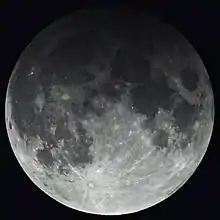July 2027 lunar eclipse
A penumbral lunar eclipse will take place on 18 July 2027.[1] The Moon will barely clip the edge of the Earth's penumbral shadow, and the eclipse will be impossible to see in practice. The event is listed as a miss[2] by some sources.
| Penumbral Lunar Eclipse 18 July 2027 | |
|---|---|
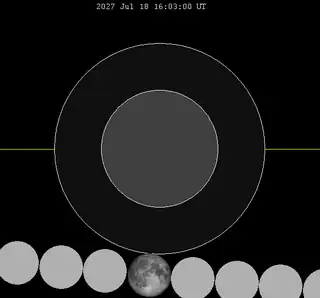 The moon will imperceptibly dim as it clips the Earth's southern penumbral shadow | |
| Series (and member) | 110 (72 of 72) |
| Gamma | -1.576 |
| Magnitude | 0.0014 |
| Duration (hr:mn:sc) | |
| Penumbral | 0:11:47 |
| Contacts | |
| P1 | 15:56:57 UTC |
| Greatest | 16:02:53 |
| P4 | 16:08:45 |
Visibility
Insofar as it is visible at all, it will be visible over Asia and Australia.

Related lunar eclipses
Eclipses in 2027
- An annular solar eclipse on 6 February.
- A penumbral lunar eclipse on 20 February.
- A penumbral lunar eclipse on 18 July.
- A total solar eclipse on 2 August.
- A penumbral lunar eclipse on 17 August.
Lunar year series
| Lunar eclipse series sets from 2027–2031 | ||||||
|---|---|---|---|---|---|---|
| Descending node | Ascending node | |||||
| Saros | Date Viewing |
Type Chart |
Saros | Date Viewing |
Type Chart | |
| 110 | 2027 Jul 18 |
Penumbral |
115 | 2028 Jan 12 |
Partial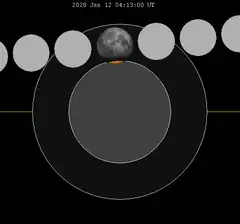 | |
| 120 | 2028 Jul 06 |
Partial |
125 | 2028 Dec 31 |
Total | |
| 130 | 2029 Jun 26 |
Total |
135 | 2029 Dec 20 |
Total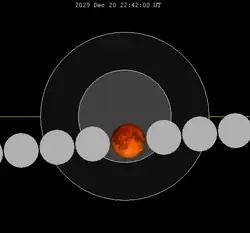 | |
| 140 | 2030 Jun 15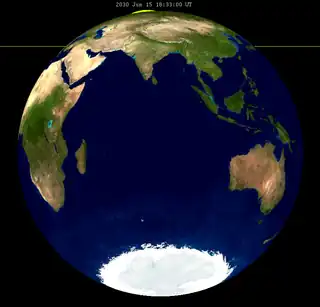 |
Partial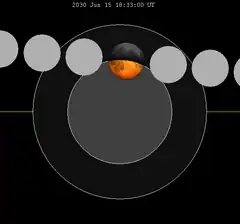 |
145 | 2030 Dec 09 |
Penumbral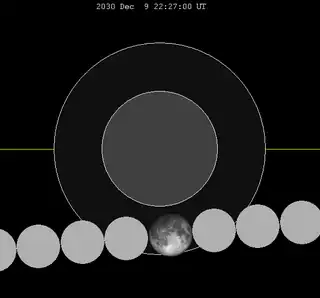 | |
| 150 | 2031 Jun 05 |
Penumbral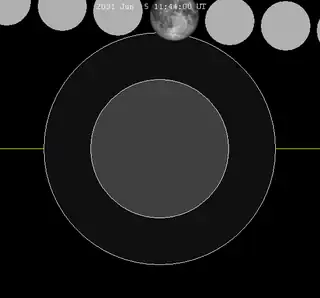 | ||||
| Last set | 2027 Aug 17 | Last set | 2027 Feb 20 | |||
| Next set | 2031 May 07 | Next set | 2031 Oct 30 | |||
Saros series
This eclipse is a member of Saros series 110. The previous event occurred on July 7, 2009. This is the last lunar eclipse of this series.
Half-Saros cycle
A lunar eclipse will be preceded and followed by solar eclipses by 9 years and 5.5 days (a half saros).[3] This lunar eclipse is related to two partial solar eclipses of Solar Saros 117.
| 13 July 2018 | 23 July 2036 |
|---|---|
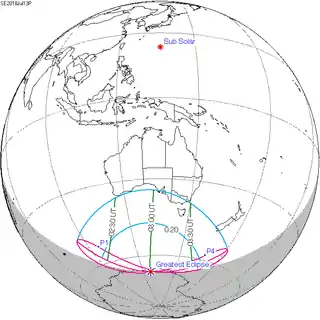 |
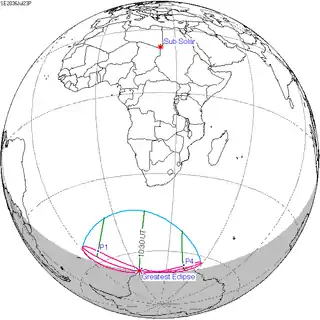 |
Notes
- Hermit Eclipse: Saros cycle 110
- "Almost Lunar Eclipse on July 18-19, 2027 – Where and when to See".
- Mathematical Astronomy Morsels, Jean Meeus, p.110, Chapter 18, The half-saros
This article is issued from Wikipedia. The text is licensed under Creative Commons - Attribution - Sharealike. Additional terms may apply for the media files.
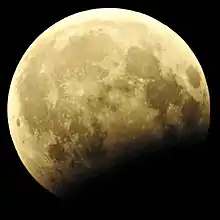
_(cropped).jpg.webp)
